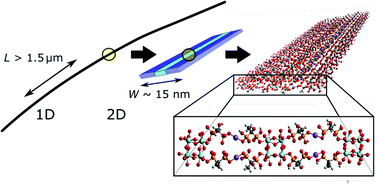Giant zirconium-bisphosphonate nano-ribbons and their liquid crystalline phase behaviour in water†
Abstract
In decimolar aqueous solutions, zirconium oxychloride octahydrate forms several micrometer long and approximately 15 nm wide thin ribbons through the reaction with excess amounts of the sodium salt of 1-hydroxyethane-1,1-diphosphonic acid (HEDP, known as etidronic acid). Primarily deduced from SAXS, TEM, EXAFS and solid-state NMR analyses, a consistent structural model enables congruous explanations for the colloidal behaviour of the purified ribbons as well as of their reaction products with ammonia and amines, respectively. Properties of the lyotropic, liquid crystalline phases are discussed in the light of potential applications in aqueous coatings.



 Please wait while we load your content...
Please wait while we load your content...